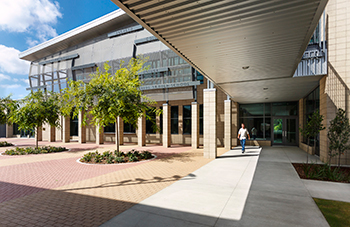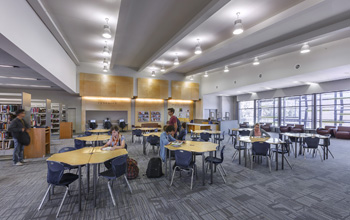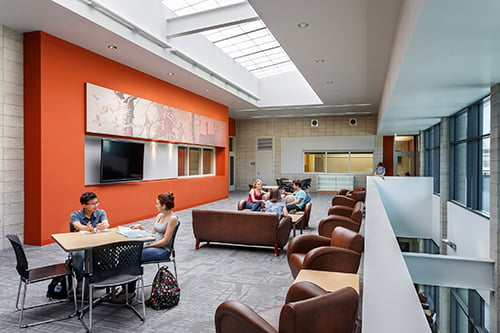From the Practical to the Poetic: Understanding Integrated Design
Brazilian architect Joao Batista Vilanova Artigas said, "I admire poets. What they express with a couple of words, requires us a ton of brick." As designers, planners, educators and builders of 21st century learning spaces, we are really dealing with far more practical realities than even a ton of brick, as Artigas describes. We aspire to address the substantial demands for practicality and at the same time achieve something more significant—something I will call “the Poetic.”
In my 33 years of practice as a planner and architect, I have often experienced a level of struggle between team members who focus on the practical demands and those who champion a bigger vision.
Who on the design team has the right focus? Do we need to care more about the practical constraints or keep our eyes on a higher outcome? Are we faced with a choice between the Practical or the Poetic?
This is a question I originally presented to a group at the Council of Educational Facility Planners International (CEFPI) Conference in Indianapolis. The annual CEFPI conference brings educators, designers, vendors and community leaders to discuss the future of education. To answer this question, let’s go back to Psychology 101 and Maslow's hierarchy of needs.
Click Play below to watch Don's "From the Practical to the Poetic" presentation at CEFPI Indianapolis.
Maslow’s hierarchy of needs organizes human motivations into a pyramid. At the base, we have the basic motivations of all living creatures: food, water and shelter. From there, the motivations build upon each other, becoming increasingly complex until we reach what Maslow considers the highest level of human motivations—self-actualization, which includes morality, creativity and understanding.
We can agree that food, water and shelter are an absolute necessity, but if we want a whole life, it can’t be the only form of motivation that we experience. As well-rounded human beings, we want to experience life to some degree on all these levels.
I adapted Maslow's scale into what I will call "The School Planner's Scale of Values".
At the base is the completely stressed school superintendent. He is faced with decaying, overcrowded facilities and an unknown number of new students showing up when school starts in September. "Just help us get roofs over kids’ heads," he says, unable to look beyond the basic practical needs at this point. Providing a durable, safe school for students is inarguably an important value, and I have actually worked with a district that was at this stage; but for students to excel in an environment, shelter really isn't enough, is it?
Here is where the Poetic comes back into play. If we outline and address all the practical realities of a project and use them to shape our design, we have a chance to create something that inherently addresses higher level values, including the aspirations of students and of the community.

-1662.jpg)
_1014.jpg) For example, at Ernest McBride High School, a small, early college and technical high school, we used an integrated process to design for between 1,000 and 1,200 students in the Long Beach Unified School District. An integrated process brings all the stakeholders and participants together at the beginning of the process to identify and consider all the goals and practical realities of the project. This included an extensive community outreach program from the start, where literally thousands of people were engaged throughout the District's master planning process.
For example, at Ernest McBride High School, a small, early college and technical high school, we used an integrated process to design for between 1,000 and 1,200 students in the Long Beach Unified School District. An integrated process brings all the stakeholders and participants together at the beginning of the process to identify and consider all the goals and practical realities of the project. This included an extensive community outreach program from the start, where literally thousands of people were engaged throughout the District's master planning process.
This moment is so important because it represents a unique opportunity to identify all the practical realities and opportunities to shape the project in meaningful, poetic ways. It will also result in a project that has improved performance efficiency overall.
A key result from the integrated design approach was establishing top goals. There was a strong sense that the spaces, inside and out, should reflect the kind of experience students would have in a collegiate setting, or in a working setting, so openness and transparency, flexibility, the idea that productive work and communication happens everywhere was sought. Here it is evident that we are addressing higher level values, and we achieved this by figuring out which design elements and constraints would provide us with this outcome.
From the collaboration spaces at the center of each career path academy, to the flexibility and transparency inherent in the classrooms, to the use of circulation and outdoor areas as learning spaces, collaboration happens everywhere at the LEED Gold McBride High. Teamwork is highly emphasized because the more students interact with each other and their environment, the richer their learning experience.
Plus, the school acts as a source of education about sustainable design. McBride High beats California Title 24 2008 standards by 40%, exceeds the current 2030 Challenge benchmark by 75% and has qualified to be a Collaborative for High Performance Schools (CHPS) verified project.
In his collection of essays, entitled “Technology, Sustainability & Cultural Identity,” educator and architect Larry Speck argues that the built environment has a unique cultural power to express our highest aspirations when we approach design through an authentic process driven by practical realities. What I’ve found to be true in my work is that we don’t face a choice between the Practical or the Poetic. Rather, it is in fact that the Practical shapes the Poetic.
Donald Pender, AIA brings more than 30 years of experience to his role as K-12 Schools designer and Principal at California-based LPA Inc. He is a LEED Accredited Professional and a Recognized Educational Facility Planner (REFP).

